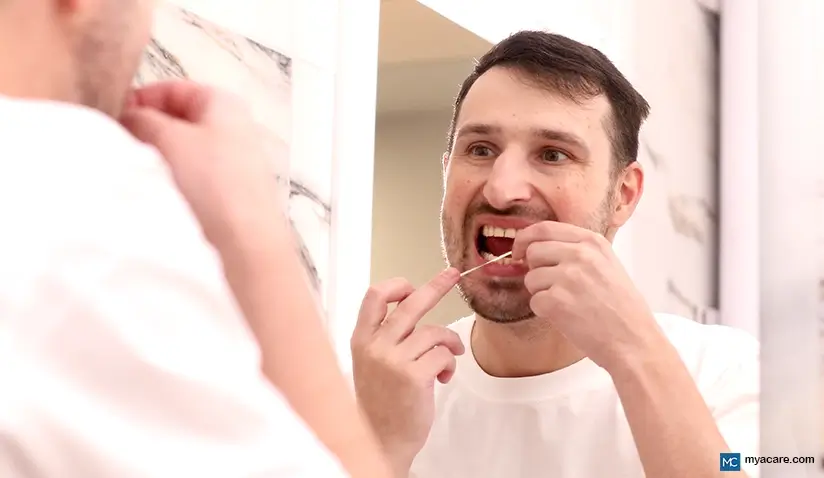How to Floss Teeth

Flossing teeth is often recommended by dentists for maintaining oral hygiene. In this practice, dental floss (a thin, thread-like material) is used to clean spaces between the teeth and underneath the gum line where a toothbrush cannot reach. Regular flossing removes the food or bacterial film (plaque) trapped between the teeth, eliminating bacterial growth. Research suggests that 80% of plaque may be removed by flossing which lowers the risk of decay and gum diseases.
However, less than 30% of adults in the US floss their teeth daily. Many don’t know how to floss correctly and find it difficult to continue flossing on a daily basis.
In this article, we discuss the technique to floss teeth and address some of the most commonly asked questions.
What are Different Materials that are Used to Produce Floss?
In the early 19th century, silk fibers were twisted to form a long strand of floss. In the 20th century, silk was replaced with nylon filaments which fray less, have better strength, and are affordable. Presently, nylon flosses are treated with flavoring agents (e.g., mint) to make the flossing experience more pleasant. Nylon flosses are available in waxed (coated with wax) and unwaxed forms.
How to Floss your Teeth?
Here is the technique to floss your teeth:
- Take about 18 inches (1.5 ft) of floss. Encircle the floss around the middle finger of one hand from one end and around the middle finger of the opposite hand from another end.
- Use the index and thumb fingers of each hand to hold the floss such that 1-2 inches of floss taut remain in between.
- Direct the thumb upwards to insert the floss between contacts of upper teeth.
- Similarly, direct the index finger to insert the floss between contacts of lower teeth.
- Once the floss is inserted between teeth, wrap it around the tooth making a C shape.
- Slide the floss gently in an upward and downward direction against the tooth surface and a little under the gumline.
- Make sure to floss around both the front and back surfaces of all your teeth.
Here’s a helpful video from the American Dental Association’s (ADA) youtube channel on the proper technique for flossing your teeth outlined above.
What are the Benefits of Flossing?
Here are some of the benefits of flossing:
- Flossing aids in the removal of food particles and debris between the teeth and underneath the gum line
- It reduces the risk of decay and gum infections, restoring the health of the gums and teeth
- It prevents bad breath
Which Floss is Best to Choose Between Waxed or Unwaxed Floss?
More than the type of floss used for flossing, the correct technique to floss is important. Research suggests no reported difference in the efficiency of waxed or unwaxed floss. People with tight contacts between teeth find waxed floss easier to pass compared to unwaxed ones. Waxed floss has higher strength and is relatively thicker. In contrast, unwaxed floss is thin and is more comfortable to use.
What are the Different Types of Floss?
There are mainly 3 different types of floss — Regular floss, Dental tape, and Super floss
- Regular floss: Regular floss is a traditional nylon floss used for cleaning food entrapped between the teeth. It comprises fine strands of nylon rolled around each other. This floss easily penetrates through the tight contacts between teeth.
- Dental tape: Dental tapes are similar to dental floss except that they have a wider surface area. This allows easy removal of plaque with an equal amount of effort as applied with dental floss. Also, the greater surface area of the dental tape reduces the risk of a cut in the fingers when wrapped around them. Similar to dental floss, dental tape is available in waxed and unwaxed forms.
- Super floss: Super floss is considered superior to regular floss. It is mainly recommended in people with large interdental spaces or with braces, a fixed prosthesis (fixed bridge), or implants. It comprises of 3 parts - a rigid end which enables easy insertion between braces or fixed clips, a middle part with a spongy floss for easy removal of the bacterial film (plaque) underneath prosthesis (fixed bridge), and the other end with a regular wax coated floss to clean the tight interdental spaces. Super floss is thicker than regular floss, so it is difficult to pass through teeth with tight contacts.
What is the Most Suitable Time to Floss your Teeth?
Flossing once a day can be performed at your convenience. Some people prefer flossing before going to bed at night, while others prefer it as a part of oral hygiene routine in the morning or after lunch. However, research suggests that flossing before brushing is an effective way to maintain oral hygiene. This practice helps enhance the fluoride concentration (delivered through toothpaste) which strengthens the enamel and resists decay. Ultimately, as long as you are doing it with the correct technique you can floss any time in a day.
Which Teeth to Floss First— Upper or Lower Teeth?
You can start from any teeth either upper or lower teeth. You can even start from the front or back teeth. Flossing with the correct technique is important. Just make sure to floss under the gum line and the back surfaces of all the teeth in the mouth.
What Precautions Should be Taken While Flossing?
- Do not apply excessive force while flossing as this can injure the gums between teeth
- Initial discomfort while flossing is common. Regular brushing and flossing will reduce the discomfort
- Consult your dentist in case of injury to the gums while flossing
Can you Reuse the Floss?
Dental floss is meant for single use. After a single use, the floss loses its effectiveness, frays away, and tends to increase the deposit of bacteria in the mouth. So please remember, the American Dental Association recommends discarding floss after one use.
Are There Any Alternatives to Dental Floss?
Some people may find flossing teeth with a dental floss a tiring procedure as it involves manual dexterity. It usually takes some time to adapt to the habit. So, other interdental cleaning aids such as floss picks (floss with a holder), tiny brushes, water flossers (device using a spray of water for cleaning), air flossers (device using stream of air for cleaning) may be recommended by a dentist. These interdental cleaning aids can be used by people who have difficulty using regular floss.
To search for the best dentists in Germany, India, Malaysia, Poland, Singapore, Spain, Thailand, Turkey, the UAE, the UK and the USA, please use the Mya Care search engine.
To search for the best healthcare providers worldwide, please use the Mya Care search engine.

Dr. Shilpy Bhandari is an experienced dental surgeon, with specialization in periodontics and implantology. She received her graduate and postgraduate education from Rajiv Gandhi University of Health Sciences in India. Besides her private practice, she enjoys writing on medical topics. She is also interested in evidence-based academic writing and has published several articles in international journals.
References:
Featured Blogs



